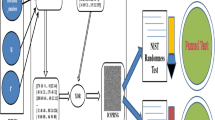Abstract
In this work we present a pseudo-random Bit Generator via unidimensional multi-modal discrete dynamical systems called k-modal maps. These multi-modal maps are based on the logistic map and are useful to yield pseudo-random sequences with longer period, i.e., in order to attend the problem of periodicity. In addition the pseudo-random sequences generated via multi-modal maps are evaluated with the statistical suite of test from NIST and satisfactory results are obtained when they are used as key stream. Furthermore, we show the impact of using these sequences in a stream cipher resulting in a better encryption quality correlated with the number of modals of the chaotic map. Finally, a statistical security analysis applied to cipher images is given. The proposed algorithm to encrypt is able to resist the chosen-plaintext attack and differential attack because the same set of encryption keys generates a different cipher image every time it is used.










Similar content being viewed by others
References
National Bureau of Standards: Data Encryption standard, Federal Information Processing Standards Publication 46. US Government Printing Office, Washington DC (1977)
National Bureau of Standards: Data encryption standard modes of operation, Federal Information Processing Standards Publication 81. US Government Printing Office, Washington DC (1980)
Menezes, A.J., Van Oorschot, P.C., Vanstone, S.A.: Handbook of Applied Cryptography. CRC Press, Boca Raton (1997)
Knudsen, L.R., Robshaw, M.J.B.: The Block Cipher Companion. Springer, Berlin (2011)
Paar, C., Pelzl, J.: Understanding Cryptography. Springer, Berlin (2010)
Mengue, A.D., Essimbi, B.Z.: C: Secure communication using chaotic synchronization in mutually coupled semiconductor lasers. Nonlinear Dyn. 70(2), 1241–1253 (2012)
Li, X., Rakkiyappan, R.: Impulsive controller design for exponential synchronization of chaotic neural networks with mixed delays. Commun. Nonlinear Sci. Numer. Simulat. 18(6), 1515–1523 (2013)
Chen, Y., Fei, S., Zhang, K.: Stabilization of impulsive switched linear systems with saturated control input. Nonlinear Dyn. 69(6), 793–804 (2012)
Ontañon-García, L.J., Campos-Cantón, E., Femat, R., Campos-Cantón, I., Bonilla-Marín, M.: Multivalued synchronization by Poincaré coupling. Commun. Nonlinear Sci. Numer. Simulat. 18(10), 2761–2768 (2013)
Kanso, A., Ghebleh, M.: A novel image encryption algorithm based on a 3D chaotic map. Commun. Nonlinear Sci. Numer. Simulat. 17(7), 2943–2959 (2012)
Alvarez, G., Li, S.: Some cryptographic requirements for Chaos-based cryptosystems. Int. J. Bifurc. Chaos 16(8), 2129–2151 (2006)
Behnia, S., Akhshani, A., Akhavan, A., Mahmodi, H.: Application of tripled chaotic maps in cryptography. Chaos Solitons Fractals 40(1), 505–519 (2009)
Andrecut, M.: Logistic map as a random number generator. Int. J. Modern Phys. B 12(9), 921–930 (1998)
**ng-Yuan, Wang, **e, Yi-**n: A design of pseudo-random bit generator based on single chaotic system. Int. J. Modern Phys. C 23(3), 1250024 (2012)
Shujun, Li, Xuanqin, Mou, Yuanlong, Cai: Pseudo-random bit generator based on couple chaotic systems and its applications in stream-cipher cryptography. Prog. cryptol.—INDOCRYPT 2247, 316–329 (2001)
Wang, X.Y., Yang, L.: Design of pseudo-random bit generator based on chaotic maps. Int. J. Modern Phys. B 26(32), 1250208 (2012)
Kanso, A., Smaoui, N.: Logistic chaotic maps for binary numbers generations. Chaos Solitons Fractals 40(5), 2557–2568 (2009)
García-Martínez, M., Campos-Cantón, E.: Pseudo-random bit generator based on lag time series. Int. J. Modern Phys. C 25(4), 1350105 (2014)
Franois, M., Grosges, T., Barchiesi, D., Erra, R.: Pseudo-random number generator based on mixing of three chaotic maps. Commun. Nonlinear Sci. Numer. Simulat. 19(4), 887–895 (2014)
Campos-Cantón, E., Femat, R., Pisarchik, A.N.: A family of multimodal dynamic maps. Commun. Nonlinear Sci. Numer. Simulat. 16(9), 3457–3462 (2011)
García-Martínez, M., Campos-Cantón, I., Campos-Cantón, E., Celikovský, S.: Difference map and its electronic circuit realization. Nonlinear Dyn. 74(3), 819–830 (2013)
Devaney, R.: An Introduction to Chaotic Dynamical Systems. Westview Press, Boulder (2003)
Li, C., Chen, G.: Estimating the Lyapunov exponents of discrete systems. Chaos 14(2), 343–346 (2004)
Yang, C., Wu, C.Q., Zhang, P.: Estimation of Lyapunov exponents from a time series for n-dimensional state space using nonlinear map**. Nonlinear Dyn. 69(4), 1496–1507 (2012)
Beker, H., Piper, F.: Cipher Systems: The Protection of Communications. Wiley, New York (1982)
Gustafson, H., Dawson, E., Nielsen, L., Caelli, W.: A computer package for measuring the strength of encryption algorithms. Comput. Secur. 13(8), 687–697 (1994)
Marsaglia, G. : DIEHARD Statistical Tests: http://www.stat.fsu.edu/pub/diehard/
A. Rukhin et al: A Statistical test suite for random and pseudo-random number generators for cryptographic applications, pp. 800–822. NIST special publication (2010)
Biham, E., Shamir, A.: Differential cryptanalysis of the data encryption standard. Springer, Newyork (1993)
IEEE Computer Society: IEEE Standard Binary Floating-Point Arithmetic, ANSI/IEEE std (1985)
Shannon, C.: Communication theory of secrecy systems. Syst. Tech. J. 28, 623 (1948)
Ahmed, H.E.D.H., Kalash, H.M., Farag Allah, O.S.: Encryption quality analysis of the RC5 block cipher algorithm for digital images. Opt. Eng. 45(10), 107003 (2006)
Acknowledgments
M. García-Martínez is doctoral fellow of the CONACYT in the Graduate Program on control and dynamical systems at DMAp-IPICYT. E. Campos-Cantón acknowledges the CONACYT financial support through project No. 181002.
Author information
Authors and Affiliations
Corresponding author
Rights and permissions
About this article
Cite this article
García-Martínez, M., Campos-Cantón, E. Pseudo-random bit generator based on multi-modal maps. Nonlinear Dyn 82, 2119–2131 (2015). https://doi.org/10.1007/s11071-015-2303-y
Received:
Accepted:
Published:
Issue Date:
DOI: https://doi.org/10.1007/s11071-015-2303-y




